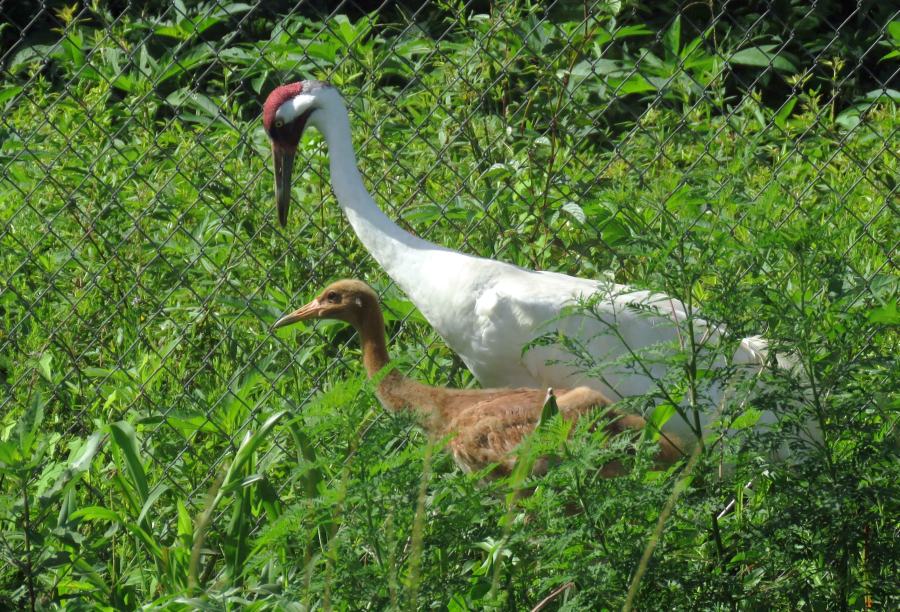NEW ORLEANS — A year after pandemic precautions all but halted work to raise the world’s most endangered cranes for release into the wild, the efforts are back in gear.
Fourteen long-legged, fuzzy brown whooping crane chicks — one more than in 2019 — are following their parents or costumed surrogates in facilities from New Orleans to Calgary, Canada.
“We are thrilled to have bounced back in the wake of the pandemic,” said Richard Dunn, assistant curator of the Freeport-McMoRan Audubon Species Survival Center in New Orleans.
Adult whooping cranes are white with black wingtips and red caps, and at 5 feet high are the tallest birds in North America. Only about 800 exist, all descendants of about 15 that survived hunters and habitat loss in a flock that migrates between Texas and Alberta.
Last year, zoos and other places where the endangered birds are bred had to cut staff and reduce or eliminate use of artificial insemination, which requires close work by two or three people, and of having people in shape-disguising costumes raise chicks.
“One chick hatched out at the Calgary Zoo,” Dunn said. “And it had to stay in Calgary because they couldn’t cross the border” to get it into either of two U.S.-only flocks.
Both a flock based in southwest Louisiana and one taught to migrate between Wisconsin and Florida by following ultralight aircraft were created in hopes of mitigating disaster should anything happen to the original border-crossing flock, now about 500 strong. The original flock is the only one that can survive without human assistance to increase its numbers.
Seven chicks hatched this year at the Species Survival Center.
Aurora, a male produced there by artificial insemination, is being brought up by his mother and “stepfather,” though his mother is temporarily hospitalized after chipping her beak.
The other six — five hatched from eggs taken from the wild in Wisconsin and one from an egg bred at the International Crane Foundation in Baraboo, Wis. — are being raised by staffers.
The Milwaukee Zoo is raising one chick from an egg received from the crane foundation, and the foundation and the Calgary Zoo are each raising three chicks. The Milwaukee Zoo’s chick will remain captive for breeding, Dunn said.
Dunn said Audubon and the crane foundation are the only facilities that use costume-rearing as well as having mated crane pairs bring up babies, and this year only Audubon did so.
Pandemic prospects were still uncertain and vaccines not yet readily available in February, when the foundation had to make its decisions, crane foundation aviculturist Kim Boardman said in an email. “We expect to costume and parent rear again in 2022.”
Audubon’s keepers do checkups and other tasks the chicks won’t appreciate while wearing regular clothes, to teach them that humans are to be avoided.
When teaching the chicks to hunt and other crane behaviors, they dress in baggy costumes with the neck of a crane-head hand puppet holding in one loose, black-tipped “wing.” The puppet demonstrates how to pick up insects from the ground, then passes the tasty morsels to a chick.
Although the chicks will be given identifying numbers such as L1-21 when they’re released as mottled brown-and-white juveniles late this year, at Audubon they have names: Blizzard, Fog, Hurricane, Lava, Lightning, Tornado — the only female — and Aurora.
It’s been a good year in the wild, too — Louisiana’s 68 adults included a record 24 nesting pairs. They hatched a record 14 chicks. including two in Texas, and five have survived into July, said Sara Zimorski, a biologist with the Louisiana Department of Wildlife and Fisheries.
Youngsters that live long enough to fly get numbers starting with LW and the number assigned at hatching. One of Louisiana’s five has been seen flying, and, along with a yearling is counted in the 70-member flock. If all five become fledglings, that will tie a record from 2018.
The Wisconsin-Florida flock numbers about 80, with about 120 birds in captivity. Seven eggs were taken from Wisconsin’s flock to be raised in captivity, at least 14 more hatched in the wild and six of those survived through June.



